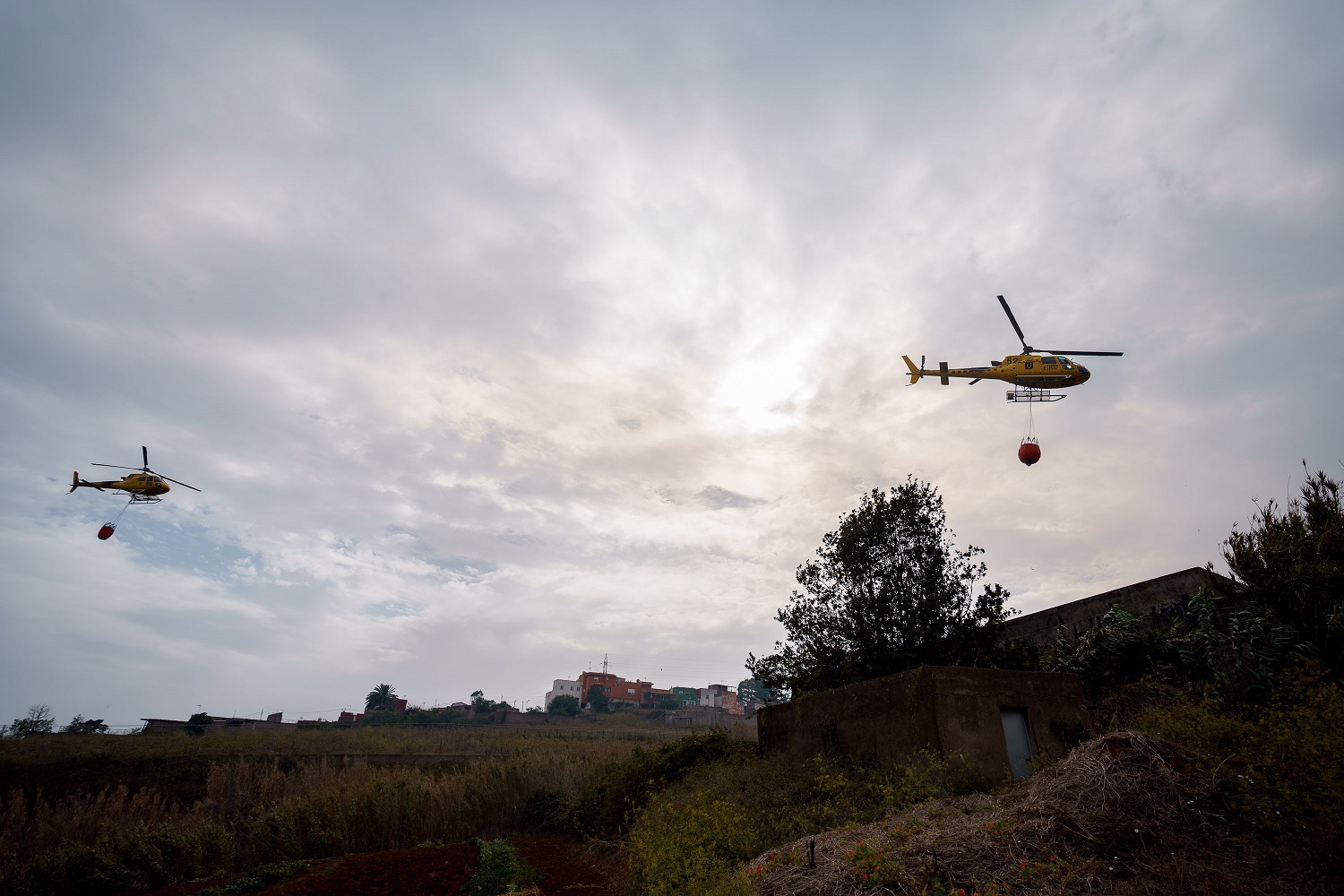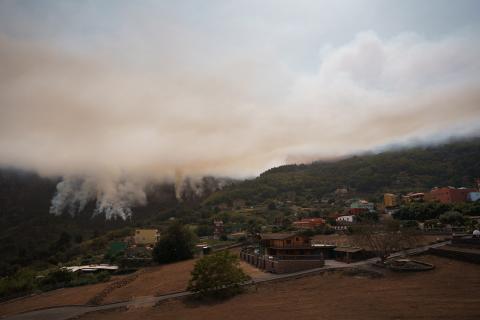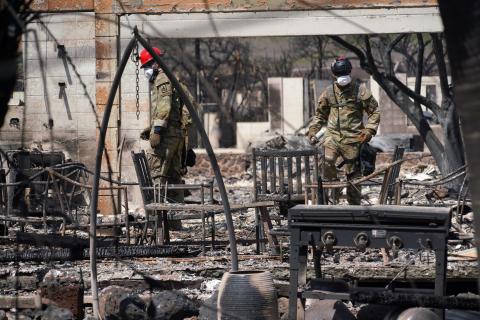Reactions: the wildfire in Tenerife forces thousands of people to evacuate although they manage to stabilize it in some points
The fire that originated on August 15 between the Tenerife municipalities of Arafo and Candelaria, in the northeast of the island, is advancing on several fronts and has affected more than 13,000 hectares, although the firefighting services have stabilized it in some points. The people evacuated in the last days have been thousands. As confirmed by the president of the Canary Islands, Fernando Clavijo, the fire has been caused.
Added new data on the fire and new assessments.

Two helicopters fly over a focus located in El Ravelo, in the municipality of El Sauzal, one of the areas affected by the forest fire declared last Tuesday in Tenerife. EFE/Ramón de la Rocha.
Eduardo Rojas - incendio Tenerife EN
Eduardo Rojas Briales
Lecturer at the Polytechnic University of Valencia and former Deputy Director-General of the FAO
Why is the fire so virulent?
“In summer the Canary Islands are affected by the trade winds that carry a lot of humidity and relatively low temperatures with a NE wind parallel to the Moroccan coast. This produces stagnant clouds and some horizontal precipitation in the mountains of the islands with higher relief at elevations 600-1,500 m. Above that altitude, which is not fixed and oscillates, the counter-trade trade that comes from the SW occurs, it is very hot and dry. Up to 2,300 m (elevation of the plain of Las Cañadas) the conditions are conducive to the Canarian pine with no other tree than a Juniperus (juniper) that resists this extreme climate. The summer is long and that area has been repopulated extensively since 1900, with which it has a lot of continuous forest mass and of a certain age with a lot of fuel available. Previously many of these areas were cultivated”.
How do these types of fires evolve?
"Not very different from those that affect natural or repopulated pine forests with high horizontal continuity on the Peninsula."
Would we be facing a megafire or sixth generation fire?
"From what is seen in the photos, yes, but you have to analyze the information from satellite images and atmospheric observation."
Can something more be done apart from what the extinction teams are already doing?
"Not directly. Previously yes: road network to gain access, clearing and pruning, prescribed burning. In Gran Canaria, which is much drier, the fire two weeks ago stopped on some 100 hectares thanks to the fact that it reached areas where forest management had been consistently practiced. In ravines, favor vegetation [and] less fuel. Where it is agronomically viable and of interest for fire prevention, recover crops such as vines to generate green barriers”.
He declares that he has no conflicts of interest: "My salary is from the university."
Jesús Santiago Notario - incendio Tenerife EN
Jesús Santiago Notario del Pino
Professor of the Department of Animal Biology, Edaphology and Geology of the University of La Laguna
Why is the fire so virulent?
"To a combination of factors: great accumulation of combustible plant mass, abandonment of the rural environment and colonization of the land by flammable vegetation, global warming, a previous strong wave of heat, etc."
How do these types of fires evolve?
“They create their own air circulation system, often unrelated to atmospheric dynamics, they produce an intense emission of airborne incandescent material (sparks) that can create new sources at a distance and they burn with such an intensity that it exceeds the extinguishing capacity of human means, whether land or air. Radiant heat is very intense, rapidly dehydrating surrounding unburned plant matter and causing it to catch fire easily. For this reason, for example, a house in the mountains limited by hedges is seriously threatened”.
Would we be facing a megafire or sixth generation fire?
“According to the technicians who work in the field, this has often happened in this case. If it is due to the affected area, I don't remember another fire like this in Tenerife”.
Can something more be done apart from what the extinction teams are already doing?
“If it refers to the extinction itself, in my opinion no, nothing. They do what they can and know how, and they are highly qualified professionals”.
Adrián Regos - incendio Tenerife EN
Adrián Regos Sanz
'Ramón y Cajal' postdoctoral researcher at the Biologial Mission of Galicia and head of the ECOP research group – Landscape Ecology
The Tenerife fire entered the sixth generation fire category on Saturday afternoon. The conditions of strong wind and low humidity are making the extinction work extremely difficult, exceeding the current extinction capacity. These extreme fires are capable of generating their own dynamics and turbulence that favor erratic and unpredictable behavior, which increases their danger.
At the level of suppression there is little more that can be done, apart from the enormous task that the suppression systems are already carrying out. It is easy for this fire to exceed 10,000 hectares, thus entering the category of mega-fire, although due to its behavior it is already an extreme fire. Prevention against these extreme events is essential. Unlike other natural disasters, these fires are somewhat predictable. There are territorial planning tools that can help create 'fire-smart' landscapes, more resistant and resilient to large fires. Said territorial management should incorporate not only different measures of sustainable forest management, but also policies that help fix the rural population whose agro-pastoral activities can help reduce the fuel load (that is, accumulation of flammable vegetation) in the territory, reducing the risk of fire. These fire prevention services must be valued by society, with the owners of the agroforestry land being beneficiaries of aid or payments for said services.
The forest-urban interface must be protected against this type of event, for which protection strips must be prepared. Society must also be aware that fire is a fundamental element of Mediterranean ecosystems and a landscape management tool that should not be demonized, but integrated as one more planning tool and comprehensive fight against future mega-fires. Controlled or prescribed burning should be seen as a vaccine. A vaccine that helps prevent the greater virulence of these new generation fires, the result of increasingly pressing climate change, in concomitance with the rural abandonment of many areas of our country.
The management and comprehensive fight against extreme fires must be comprehensive, transversal to many socioeconomic sectors of our society and based on sustainable environmental solutions. These solutions exist and must be analyzed and valued from a social, economic and environmental point of view.



